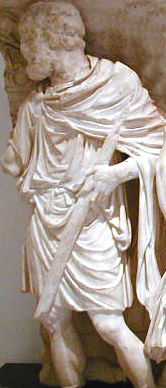
tunica

The tunic was a loose, traditionally white shift, made of wool and short-sleeved or sleeveless. It was worn by Roman men under the toga, by Roman women under the stola and palla, and by slaves and foreigners as well. Belted and pulled up to knee length, it was the clothing of choice when at home, at work, and generally anywhere outside of Rome (as a result, Martial in Epigrammata 10.96.11-12 observes that a single toga lasts him four years in the country, while in the city he wears out four in a year; in Epigrammata 10.51.6, Martial describes the peacefulness of the country as tunicata quies). Martial calls thickly woven tunics (trilices, triple-woven, clearly designed for warmth) tunicae patavinae (Epigrammata 14.140).
While there is disagreement over the colors of the military tunic, it is clear that it, as the toga, bore the marks of a man's social and political status. Umbricius observes that local aediles outside of Rome could be found at the theater without their toga, satisfied to wear a plain white tunic rather than the tunica laticlavia (see below) or the tunica augusticlavia, which municipal officials had the right to wear (cf. Horace, Sermones I.5.34-36).
